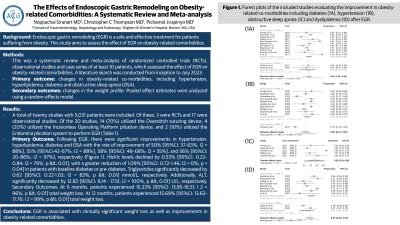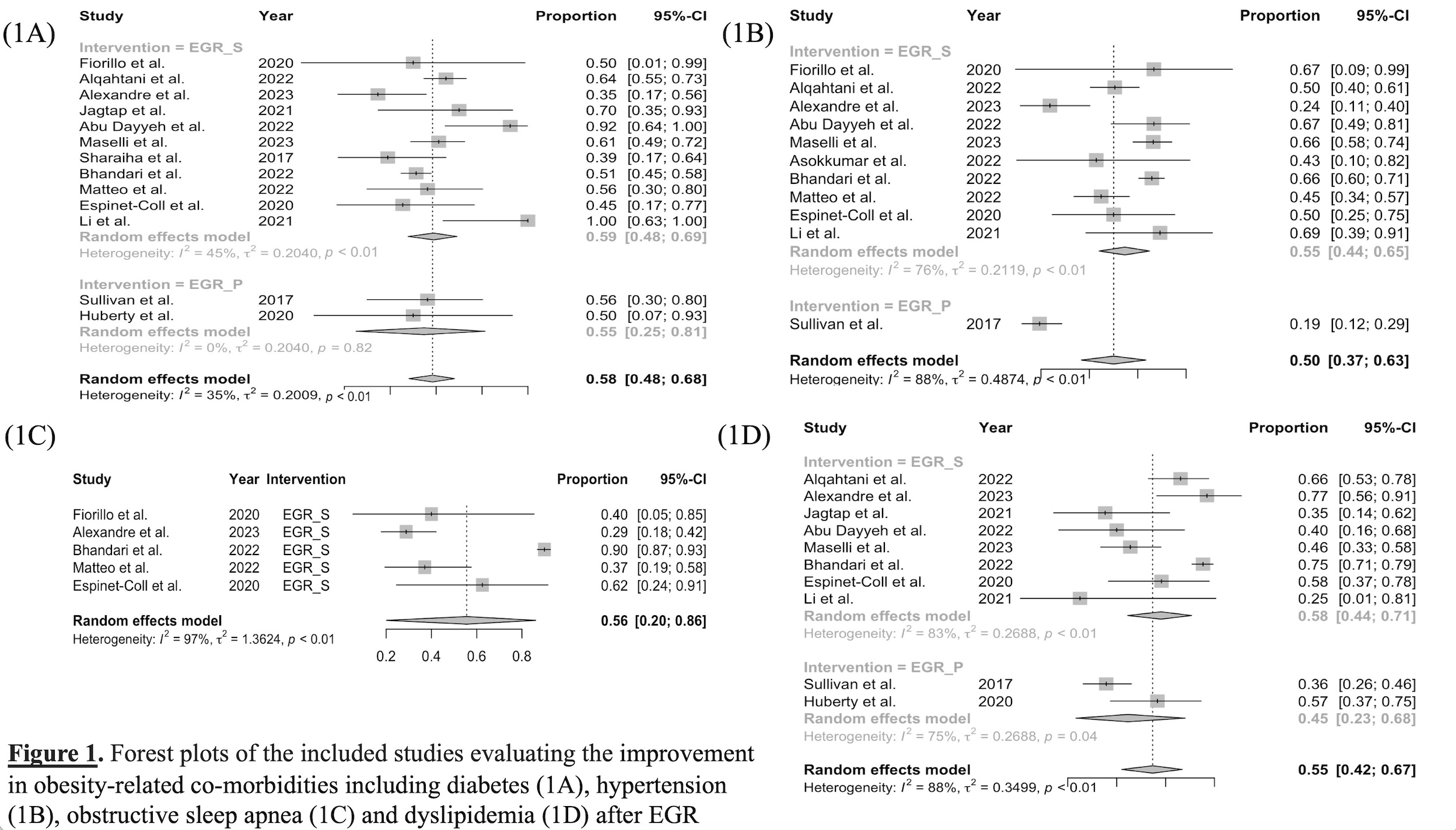Tuesday Poster Session
Category: Obesity
P4883 - The Effects of Endoscopic Gastric Remodeling on Obesity-Related Comorbidities: A Systematic Review and Meta-Analysis
Tuesday, October 29, 2024
10:30 AM - 4:00 PM ET
Location: Exhibit Hall E

Has Audio

Noppachai Siranart, MD
Brigham and Women's Hospital
Boston, MA
Presenting Author(s)
Noppachai Siranart, MD1, Christopher C.. Thompson, MD, MSc2, Pichamol Jirapinyo, MD, MPH3
1Brigham and Women's Hospital, Boston, MA; 2Brigham and Women's Hospital, Harvard Medical School, Boston, MA; 3Brigham and Women's Hospital, Boston, MA
Introduction: Endoscopic gastric remodeling (EGR) is a safe and effective treatment for patients suffering from obesity. This study aims to assess the effect of EGR on obesity-related comorbidities.
Methods: This was a systematic review and meta-analysis of randomized controlled trials (RCTs), observational studies and case series of at least 10 patients, which assessed the effect of EGR on obesity-related comorbidities. A literature search was conducted from inception to July 2023. The primary outcomes were changes in obesity-related co-morbidities, including hypertension, hyperlipidemia, diabetes and obstructive sleep apnea (OSA). Secondary outcomes were changes in the weight profile. Pooled effect estimates were analyzed using a random-effects model.
Results: A total of twenty studies with 5,031 patients were included. Of these, 3 were RCTs and 17 were observational studies. Of the 20 studies, 14 (70%) utilized the Overstitch suturing device, 4 (20%) utilized the Incisionless Operating Platform plication device, and 2 (10%) utilized the Endomina plication system to perform EGR (Table 1). Primary Outcomes: Following EGR, there were significant improvements in hypertension, hyperlipidemia, diabetes and OSA with the rate of improvement of 50% [95%CI: 37–63%; I2 = 88%], 55% [95%CI: 42–67%; I2 = 88%], 58% [95%CI: 48–68%; I2 = 35%], and 56% [95%CI: 20–86%; I2 = 97%], respectively (Figure 1). HbA1c levels declined by 0.53% [95%CI: 0.22–0.84; I2 = 79%, p < 0.01], with a greater reduction of 1.09% [95%CI: 0.72–1.46; I2 = 0%, p = 0.04] in patients with baseline diabetes or pre-diabetes. Triglycerides significantly decreased by 0.62 [95%CI: 0.22-1.03; I2 = 83%, p < 0.01] mmol/L, respectively. Additionally, ALT, significantly decreased by 12.82 [95%CI: 8.14 - 17.51; I2 = 100%, p < 0.01] U/L, respectively. Secondary Outcomes: At 6 months, patients experienced 15.23% [95%CI: 13.95–16.51; I2 = 96%, p < 0.01] total weight loss. At 12 months, patients experienced 15.69% [95%CI: 13.63–17.76; I2 = 99%, p < 0.01] total weight loss.
Discussion: EGR is associated with clinically significant weight loss as well as improvements in obesity-related comorbidities.

Note: The table for this abstract can be viewed in the ePoster Gallery section of the ACG 2024 ePoster Site or in The American Journal of Gastroenterology's abstract supplement issue, both of which will be available starting October 27, 2024.
Disclosures:
Noppachai Siranart, MD1, Christopher C.. Thompson, MD, MSc2, Pichamol Jirapinyo, MD, MPH3. P4883 - The Effects of Endoscopic Gastric Remodeling on Obesity-Related Comorbidities: A Systematic Review and Meta-Analysis, ACG 2024 Annual Scientific Meeting Abstracts. Philadelphia, PA: American College of Gastroenterology.
1Brigham and Women's Hospital, Boston, MA; 2Brigham and Women's Hospital, Harvard Medical School, Boston, MA; 3Brigham and Women's Hospital, Boston, MA
Introduction: Endoscopic gastric remodeling (EGR) is a safe and effective treatment for patients suffering from obesity. This study aims to assess the effect of EGR on obesity-related comorbidities.
Methods: This was a systematic review and meta-analysis of randomized controlled trials (RCTs), observational studies and case series of at least 10 patients, which assessed the effect of EGR on obesity-related comorbidities. A literature search was conducted from inception to July 2023. The primary outcomes were changes in obesity-related co-morbidities, including hypertension, hyperlipidemia, diabetes and obstructive sleep apnea (OSA). Secondary outcomes were changes in the weight profile. Pooled effect estimates were analyzed using a random-effects model.
Results: A total of twenty studies with 5,031 patients were included. Of these, 3 were RCTs and 17 were observational studies. Of the 20 studies, 14 (70%) utilized the Overstitch suturing device, 4 (20%) utilized the Incisionless Operating Platform plication device, and 2 (10%) utilized the Endomina plication system to perform EGR (Table 1). Primary Outcomes: Following EGR, there were significant improvements in hypertension, hyperlipidemia, diabetes and OSA with the rate of improvement of 50% [95%CI: 37–63%; I2 = 88%], 55% [95%CI: 42–67%; I2 = 88%], 58% [95%CI: 48–68%; I2 = 35%], and 56% [95%CI: 20–86%; I2 = 97%], respectively (Figure 1). HbA1c levels declined by 0.53% [95%CI: 0.22–0.84; I2 = 79%, p < 0.01], with a greater reduction of 1.09% [95%CI: 0.72–1.46; I2 = 0%, p = 0.04] in patients with baseline diabetes or pre-diabetes. Triglycerides significantly decreased by 0.62 [95%CI: 0.22-1.03; I2 = 83%, p < 0.01] mmol/L, respectively. Additionally, ALT, significantly decreased by 12.82 [95%CI: 8.14 - 17.51; I2 = 100%, p < 0.01] U/L, respectively. Secondary Outcomes: At 6 months, patients experienced 15.23% [95%CI: 13.95–16.51; I2 = 96%, p < 0.01] total weight loss. At 12 months, patients experienced 15.69% [95%CI: 13.63–17.76; I2 = 99%, p < 0.01] total weight loss.
Discussion: EGR is associated with clinically significant weight loss as well as improvements in obesity-related comorbidities.

Figure: Figure 1: Forest plots of the included studies evaluating the improvement in obesity-related co-morbidities including diabetes (1A), hypertension (1B), obstructive sleep apnea (1C) and dyslipidemia (1D) after EGR.
Note: The table for this abstract can be viewed in the ePoster Gallery section of the ACG 2024 ePoster Site or in The American Journal of Gastroenterology's abstract supplement issue, both of which will be available starting October 27, 2024.
Disclosures:
Noppachai Siranart indicated no relevant financial relationships.
Christopher Thompson: Apollo Endosurgery – Consultant, Grant/Research Support. Bariendo – Consultant, Founder, Owner/Ownership Interest. Boston Scientific – Consultant, Grant/Research Support. Endoquest Robotics – Advisory Committee/Board Member, Consultant, Grant/Research Support. Endosim – Royalties. Enterasense Ltd. – Advisory Committee/Board Member, Consultant, Founder, Owner/Ownership Interest, Stock Options. EnVision Endoscopy – Advisory Committee/Board Member, Consultant, Founder, Owner/Ownership Interest, Stock Options. ERBE – Grant/Research Support. Fractyl – Consultant, Grant/Research Support, Stock Options. Fujifilm – Grant/Research Support. GI Dynamics – Consultant, Grant/Research Support. GI Windows – Advisory Committee/Board Member, Consultant, Founder, Owner/Ownership Interest, Royalties, Stock Options. Lumendi – Grant/Research Support. Medtronic – Advisory Committee/Board Member, Consultant. Olympus – Consultant, Grant/Research Support. USGI Medical – Advisory Committee/Board Member, Consultant, Grant/Research Support. Xenter – Advisory Committee/Board Member, Consultant.
Pichamol Jirapinyo: Apollo Endosurgery – Consultant, Grant/Research Support. Bariendo – Advisory Committee/Board Member, Consultant, Owner/Ownership Interest. Boston Scientific – Consultant, Grant/Research Support. Cook Medical – Consultant. Endosim – Royalties. ERBE – Consultant. Fractyl – Consultant, Grant/Research Support. GI Dynamics – Consultant, Grant/Research Support. Madrigal – Consultant. Spatz – Consultant. USGI Medical – Consultant, Grant/Research Support.
Noppachai Siranart, MD1, Christopher C.. Thompson, MD, MSc2, Pichamol Jirapinyo, MD, MPH3. P4883 - The Effects of Endoscopic Gastric Remodeling on Obesity-Related Comorbidities: A Systematic Review and Meta-Analysis, ACG 2024 Annual Scientific Meeting Abstracts. Philadelphia, PA: American College of Gastroenterology.
